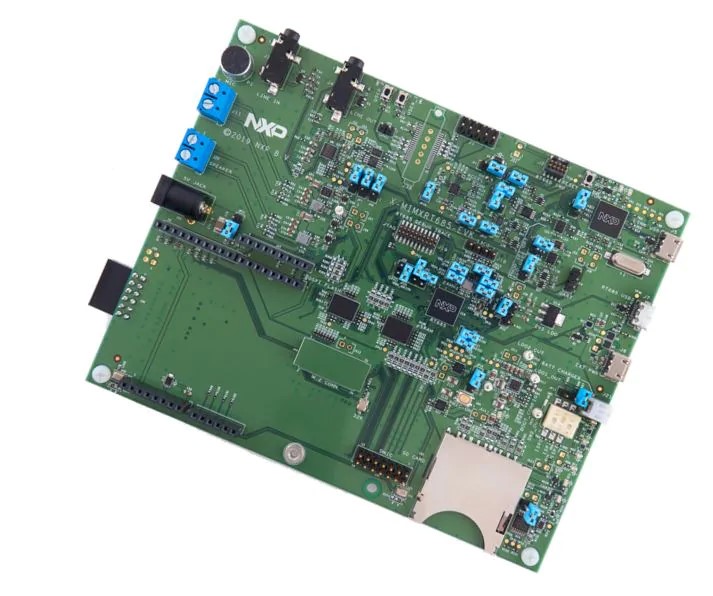NXP MIMXRT685-EVK¶
Overview¶
The i.MX RT600 is a crossover MCU family optimized for 32-bit immersive audio playback and voice user interface applications combining a high-performance Cadence Tensilica HiFi 4 audio DSP core with a next-generation Cortex-M33 core. The i.MX RT600 family of crossover MCUs is designed to unlock the potential of voice-assisted end nodes with a secure, power-optimized embedded processor.
The i.MX RT600 family provides up to 4.5MB of on-chip SRAM and several high-bandwidth interfaces to access off-chip flash, including an Octal/Quad SPI interface with an on-the-fly decryption engine.

Hardware¶
MIMXRT685SFVKB Cortex-M33 (300 MHz, 128 KB TCM) core processor with Cadence Xtensa HiFi4 DSP
Onboard, high-speed USB, Link2 debug probe with CMSIS-DAP protocol (supporting Cortex M33 debug only)
High speed USB port with micro A/B connector for the host or device functionality
UART, I2C and SPI port bridging from i.MX RT685 target to USB via the on-board debug probe
512 MB Macronix Octal SPI Flash operating at 1.8 V
4.5 MB Apmemory PSRAM
Full size SD card slot (SDIO)
NXP PCA9420UK PMIC
User LEDs
Reset and User buttons
Arduino and PMod/Host expansion connectors
NXP FXOS8700CQ accelerometer
Stereo audio codec with line in/out and electret microphone
Stereo NXP TFA9894 digital amplifiers, with option for external +5V power for higher performance speakers
Support for up to eight off-board digital microphones via 12-pin header
Two on-board DMICS
For more information about the MIMXRT685 SoC and MIMXRT685-EVK board, see these references:
Supported Features¶
The mimxrt685_evk board configuration supports the following hardware features:
Interface |
Controller |
Driver/Component |
|---|---|---|
NVIC |
on-chip |
nested vector interrupt controller |
SYSTICK |
on-chip |
systick |
OS_TIMER |
on-chip |
os timer |
IOCON |
on-chip |
pinmux |
GPIO |
on-chip |
gpio |
FLASH |
on-chip |
OctalSPI Flash |
USART |
on-chip |
serial port-polling |
I2C |
on-chip |
i2c |
SPI |
on-chip |
spi |
I2S |
on-chip |
i2s |
CLOCK |
on-chip |
clock_control |
The default configuration can be found in the defconfig file:
boards/arm/mimxrt685_evk/mimxrt685_evk_cm33_defconfig
Other hardware features are not currently supported by the port.
Connections and IOs¶
The MIMXRT685 SoC has IOCON registers, which can be used to configure the functionality of a pin.
Name |
Function |
Usage |
|---|---|---|
PIO0_2 |
USART |
USART RX |
PIO0_1 |
USART |
USART TX |
PIO0_14 |
GPIO |
GREEN LED |
PIO1_1 |
GPIO |
SW0 |
PIO0_17 |
I2C |
I2C SDA |
PIO0_18 |
I2C |
I2C SCL |
PIO1_5 |
GPIO |
FXOS8700 TRIGGER |
PIO1_5 |
SPI |
SPI MOSI |
PIO1_4 |
SPI |
SPI MISO |
PIO1_3 |
SPI |
SPI SCK |
PIO1_6 |
SPI |
SPI SSEL |
PIO0_23 |
I2S |
I2S DATAOUT |
PIO0_22 |
I2S |
I2S TX WS |
PIO0_21 |
I2S |
I2S TX SCK |
PIO0_9 |
I2S |
I2S DATAIN |
PIO1_11 |
FLEXSPI0B_DATA0 |
OctalSPI Flash |
PIO1_12 |
FLEXSPI0B_DATA1 |
OctalSPI Flash |
PIO1_13 |
FLEXSPI0B_DATA2 |
OctalSPI Flash |
PIO1_14 |
FLEXSPI0B_DATA3 |
OctalSPI Flash |
PIO1_29 |
FLEXSPI0B_SCLK |
OctalSPI Flash |
PIO2_12 |
PIO2_12 |
OctalSPI Flash |
PIO2_17 |
FLEXSPI0B_DATA4 |
OctalSPI Flash |
PIO2_18 |
FLEXSPI0B_DATA5 |
OctalSPI Flash |
PIO2_19 |
FLEXSPI0B_SS0_N |
OctalSPI Flash |
PIO2_22 |
FLEXSPI0B_DATA6 |
OctalSPI Flash |
PIO2_23 |
FLEXSPI0B_DATA7 |
OctalSPI Flash |
System Clock¶
The MIMXRT685 EVK is configured to use the OS Event timer as a source for the system clock.
Serial Port¶
The MIMXRT685 SoC has 8 FLEXCOMM interfaces for serial communication. One is configured as USART for the console and the remaining are not used.
Programming and Debugging¶
Build and flash applications as usual (see Building an Application and Run an Application for more details).
Configuring a Debug Probe¶
A debug probe is used for both flashing and debugging the board. This board is configured by default to use the LPC-Link2.
LPC-Link2 J-Link Onboard Debug Probe¶
Install the J-Link Debug Host Tools and make sure they are in your search path.
Follow the instructions in LPC-Link2 J-Link Onboard Debug Probe to program the J-Link firmware. Please make sure you have the latest firmware for this board.
Configuring a Console¶
Connect a USB cable from your PC to J16, and use the serial terminal of your choice (minicom, putty, etc.) with the following settings:
Speed: 115200
Data: 8 bits
Parity: None
Stop bits: 1
Flashing¶
Here is an example for the Hello World application. This example uses the J-Link Debug Host Tools as default.
# From the root of the zephyr repository
west build -b mimxrt685_evk_cm33 samples/hello_world
west flash
Open a serial terminal, reset the board (press the RESET button), and you should see the following message in the terminal:
***** Booting Zephyr OS v1.14.0 *****
Hello World! mimxrt685_evk_cm33
Debugging¶
Here is an example for the Hello World application. This example uses the J-Link Debug Host Tools as default.
# From the root of the zephyr repository
west build -b mimxrt685_evk_cm33 samples/hello_world
west debug
Open a serial terminal, step through the application in your debugger, and you should see the following message in the terminal:
***** Booting Zephyr OS zephyr-v2.3.0 *****
Hello World! mimxrt685_evk_cm33